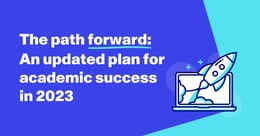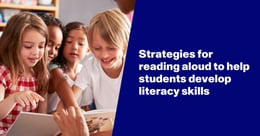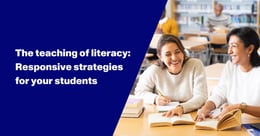
Raising reading fluency to improve K-12 literacy
See if you can crack this code: Uoy era won gnicitcarp tahw ti sleef ekil ot daer yltneulfsid.
Chances are that you could do it with a bit of effort. But didn’t it feel clunky and awkward? By the time you got to the end of the sentence, you probably had to take an extra step back to think about what you’d just read.
Keep that feeling in mind, because in a little bit, we’re going to talk about how important reading fluency can be for students who are in the process of developing their literacy skills.
But why are we so focused on literacy in the first place?
Why is literacy important?: A refresher
Fundamentally, literacy is important because it’s a prerequisite skill for unlocking many other opportunities, including learning in a variety of different subject areas and basic communication.
What’s more, the ability to read—and to read well—is truly transformative.
Education Development Center’s Simon Richmond has a particularly compelling take on why literacy matters.
“When a child learns to read, she unlocks and accelerates an expanding process of re-forming her self-identity and of enacting her will within the world,” says Richmond.
This still holds true in the 21st century, an era in which new communication channels that don’t rely on text—such as videoconferencing—have become increasingly widespread. Alongside these new tools, the written word still retains a fundamental place in modern workplaces and educational environments, as well as at home.
Literacy trends: A nationwide snapshot
Unfortunately, national literacy rates are not where they need to be.
According to the Barbara Bush Foundation for Family Literacy, about 130 million Americans do not have proficient literacy skills. This number focuses on individuals between the ages of 16 and 74, but it’s not hard to imagine how early struggles with reading can translate into these kinds of long-lasting literacy challenges.
Drawing on data from the National Assessment of Educational Progress, the National Center for Education Statistics reported that average reading scores declined from 2017 to 2019 for students in fourth and eighth grade.
On top of this, pandemic-related unfinished learning has many education leaders on edge, and lots of these teachers and administrators are looking for new solutions to help accelerate student learning.
Reading fluency: A key pillar of literacy
There are many foundational skills that help students become expert readers. Reading fluency is one of these vitally important abilities.
[READ: “How to teach reading: The K-12 guide”]
According to a teachers’ resource on fluency from the Literacy Education and Resource Network—part of the Childhood Learning Initiative—fluency is “the ability to read words accurately, smoothly, and with expression.” In discussing the impacts of achieving reading fluency, the Institute of Reading Development points out that fluency can serve as a gateway to greater comprehension skills and a lasting love of reading.
Think back to our exercise at the start of this article. In all likelihood, you spent so much effort just decoding the words in front of you that there was little chance you’d be able to read them smoothly or expressively.
When we read fluently, our minds are free to focus on the meaning of the words in front of us, which makes the process feel significant and enriching.
How Paper™ supports students by building reading fluency and better habits with Paper Reading
With the recent announcement about Paper’s acquisition of Readlee, students who have access to Paper’s Educational Support System (ESS) will gain access to Paper Reading, a new program within Paper’s ESS that leverages technology developed by Readlee.
With Paper Reading, learners from our partner districts will be able to build reading fluency skills as they practice reading out loud, and they’ll receive immediate feedback from the program.
Specifically, Paper Reading supports students as they work to improve three fundamental aspects of reading fluency:
- Accuracy
- Speed
- Prosody
On the platform, learners can record themselves reading a passage of their own choosing or assigned material. After the recording is submitted, they’ll receive important key metrics, such as time read, words correct per minute, total words read, and unique words. Paper Reading also keeps track of a student’s sessions over time, helping them see how their ongoing efforts translate into cumulative data gathered from every independent practice session.
Practice makes perfect
As students continue to practice reading out loud, they’ll gain valuable support in building up their reading fluency. And as their fluency skills improve, they’ll be able to focus on comprehension, setting the stage for these learners to discover the books that will make them fall in love with reading forever.
In this way, we believe Paper Reading has a role to play in turning around the discouraging literacy trends that our schools are currently working ceaselessly to remedy.
Do you have Paper? Tell your students to log in today to try out Paper Reading with a text of their choice! Don’t have Paper in your district yet? Check out our teacher advocacy kit for helpful suggestions as you make the case for Paper’s ESS.






